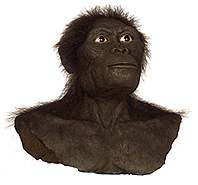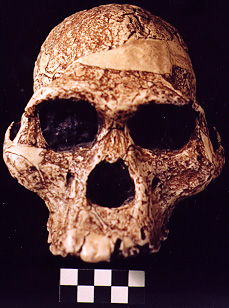Australopithecus africanus

 An Australian anatomist at the University of the Witwatersrand, Johannesburg,
South Africa, named Raymond Dart, discovered the first australopithecine in November 1924 and published his interpretation of it in the journal Nature in February 1925. The fossil was that of an immature apelike individual and was found at a lime quarry at Taung, southwest of Johannesburg. The fossil existed of the face, part of the cranium, the complete lower jaw and a brain endocast, formed when sand inside the skull hardened to rock, recording the shape of the brain.
An Australian anatomist at the University of the Witwatersrand, Johannesburg,
South Africa, named Raymond Dart, discovered the first australopithecine in November 1924 and published his interpretation of it in the journal Nature in February 1925. The fossil was that of an immature apelike individual and was found at a lime quarry at Taung, southwest of Johannesburg. The fossil existed of the face, part of the cranium, the complete lower jaw and a brain endocast, formed when sand inside the skull hardened to rock, recording the shape of the brain.
In the Nature paper published by Dart, he stated that the Taung individual was an earlier form of human, and named it Australopithecus africanus ("southern ape from Africa"). When a Scottish paleontologist named Robert Broom, joined in the search for early hominid fossils with Dart, they soon discovered other examples of australopithecine. Australopithecus africanus appeared to be apelike in having a protruding face and small brain, but had distinctly unapelike dentition, including small canines and large, flat molars. A bipedal posture was again indicated by the central position of the foramen magnum, and by the anatomy of the spine, pelvis, and femur.
Broom also discovered fossils which were thought to be
similar in many ways to Australopithecus africanus,
but which were more "robustly" built. The fossils
exhibited larger jaws and teeth and after discovering many
more differences, Broom decided to group these discoveries
to a new species name of
Australopithecus robustus.
Dating these South African australopithecines has been a difficult task, because their cave context is not appropriate for radiometric dating. Ranges have been tentatively suggested for 3.5 to 2.5 million years for the gracile australopithecines and 2.0 to 1.0 million years for the robust species.

This table shows the main morphological differences between the
two main members of the so-called "gracile" Australopithecine family;
Australopithecus afarensis
and Australopithecus africanus.
|
|
A. afarensis |
A. africanus |
|
Height |
1.0 - 1.5 metres |
1.1 - 1.4 metres |
|
Weight |
30 - 70 kg |
30 - 60 kg |
|
Cranial Volume |
400 - 500 cc |
400 - 500 cc |
|
Known Date |
4.0 - 2.5 million years ago |
3.0 - 2.5 million years ago |
|
Distribution |
Eastern Africa |
Southern Africa |
|
Physique |
Light build; some ape-like features |
Light build; probably relatively long arms; more "human" features |
|
Skull form |
Low, flat forehead; projecting face; prominent brow ridges |
Higher forehead; shorter face; brow ridges less prominent |
|
Jaws/Teeth |
Relatively large incisors and canines; gap between upper incisors and canines; moderate-sized molars |
Small incisor-like canines; no gap between upper incisors and canines; larger molars |
|
Sexual Dimorphism |
Marked to moderate |
Probably less than A. afarensis |
|
Ardipithecus ramidus
|
Australopithecus anamensis
|
Australopithecus afarensis
|
|
Australopithecus africanus
|
Australopithecus aethiopicus
|
Australopithecus boisei
|
|
Australopithecus robustus
|
Homo habilis
|
Homo rudolfensis
|
Homo erectus
|
Homo ergaster
|
|
Homo heidelbergensis
|
Homo neanderthalensis
|
Homo sapiens
|
 An Australian anatomist at the University of the Witwatersrand, Johannesburg,
South Africa, named Raymond Dart, discovered the first australopithecine in November 1924 and published his interpretation of it in the journal Nature in February 1925. The fossil was that of an immature apelike individual and was found at a lime quarry at Taung, southwest of Johannesburg. The fossil existed of the face, part of the cranium, the complete lower jaw and a brain endocast, formed when sand inside the skull hardened to rock, recording the shape of the brain.
An Australian anatomist at the University of the Witwatersrand, Johannesburg,
South Africa, named Raymond Dart, discovered the first australopithecine in November 1924 and published his interpretation of it in the journal Nature in February 1925. The fossil was that of an immature apelike individual and was found at a lime quarry at Taung, southwest of Johannesburg. The fossil existed of the face, part of the cranium, the complete lower jaw and a brain endocast, formed when sand inside the skull hardened to rock, recording the shape of the brain.
